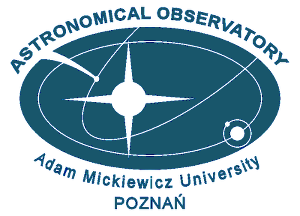Web services
Gaia-GOSA ISAM Asteroid Spin Vector Database IAU MDC Meteor Showers Database CODE Database StePPeD Database
Gaia-GOSA
http://www.gaiagosa.eu
Gaia-Groundbased Observational Service for Asteroids (Gaia-GOSA) is an interactive tool aiming to facilitate asteroid observers in contributing to the Gaia mission (European Space Agency) by gathering lightcurves of selected targets. GOSA users can plan their observing runs by selecting the visible targets for a given date, collaborate with other observers and upload the frames obtained. OA UAM team is responsible for analyzing the data, publishing the results in the website and creating a lightcurve catalog. Once calibrated, lightcurves will be easily included in the analysis of Gaia data, which will allow to enhance the determination of asteroids’ physical properties.
References:
Santana-Ros et al. 2014, EAS Publications Series, 67-68, 109
Santana-Ros et al. 2016, The Minor Planet Bulletin, 43, 205
ISAM
http://isam.astro.amu.edu.pl
On the Interactive Service for Asteroid Models (ISAM) webpage, one can choose a polyhedral asteroid model and display its orientation for any requested date and in different modes, including stereoscopic views. One can also generate animations, both for the rotating model and the resulting lightcurve. Making predictions for the future light variations and object orientations is also possible. The latter is particularly useful in preparation of resolved observations such as stellar occultations or adaptive optics.
References:
Marciniak et al. 2012, Astronomy and Astrophysics, 545, A131
Asteroid Spin Vector Database
http://www.astro.amu.edu.pl/ASV/asvHome.php
Originally created by Per Magnusson, at that time working at the Uppsala Observatory (Sweden), is currently maintained by Agnieszka Kryszczyńska. It provides data on asteroid spin vectors (given as the geocentric, ecliptic pole coordinates) and, in many cases, sidereal periods of rotation and shapes.
Please use the following citation to reference this data set: Kryszczynska A., La Spina A., Paolicchi P., Harris A.W., Breiter S., Pravec P., 2007, New findings on asteroid spin-vector distributions, Icarus 192, 223-237.
IAU MDC Meteor Showers Database
http://www.astro.amu.edu.pl/~jopek/MDC2007/index.php
Meteor Showers Database is maintained by Meteor Database Center (MDC) of International Astronomical Union (IAU). It contains information about names, radiants, velocities and orbital elements of more than 500 meteoroid showers.
References:
Jopek T.J., Kanuchova Z. (2014), Current status of the IAU MDC Meteor Showers Database Meteoroids 2013, Proceedings of the Astronomical Conference, held at A.M. University, Poznan, Poland, Aug. 26-30, 2013, eds Jopek T.J., Rietmeijer F.J.M., Watanabe J., Williams I.P., Adam Mickiewicz University Press in Poznan, pp 353–364
CODE Database
https://pad2.astro.amu.edu.pl/CODE/
https://code.cbk.waw.pl
Catalogue of Cometary Orbits and their Dynamical Evolution (CODE) is a public database prepared in cooperation between Space Research Centre of Polish Academy of Sciences and the Astronomical Observatory Institute, A.Mickiewicz University.
CODE catalogue currently provides information about orbits of almost 300 near-parabolic comets with original gravitational semimajor axes greater than 10,000 au and discovered between the years 1885—2017.
This is the first catalogue showing orbital evolution of long-period comets during the three consecutive perihelion passages: previous — observed — next, and covering their dynamical evolution over a period of typically 1–10 million years.
References:
Małgorzata Królikowska & Piotr A. Dybczyński, The catalogue of cometary orbits and their dynamical evolution, 2020, Astronomy & Astrophysics, Volume 640, id.A97
StePPeD Database
https://pad2.astro.amu.edu.pl/StePPeD
The StePPeD database contains current data on the potential stellar perturbers of long period comet motion. It provides data both on single stars and multiple systems that according to the contemporary kinematic and astrometric data have passed closer than 4 pc to the Sun or will pass at that distance in the future.
This database currently contains information on over 800 objects, including astrometric and kinematic data, distance and mass estimates together with their uncertainties and sources. Most of the data is based on the Gaia DR2 catalogue, augmented by the information form the SIMBAD database.
References:
Rita Wysoczańska, Piotr A. Dybczyński, Magdalena Polińska, A surprise in the updated list of stellar perturbers of long-period comet motion, 2020, Astronomy & Astrophysics, Volume 640, id.A129

